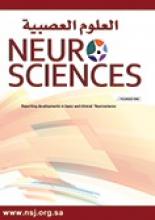Systematic ReviewSystematic Review
Open Access
Diagnostic effectiveness of deep learning-based MRI in predicting multiple sclerosis: A meta-analysis
Tareef S. Daqqaq, Ayman S. Alhasan and Hadeel A. Ghunaim
Neurosciences Journal April 2024, 29 (2) 77-89; DOI: https://doi.org/10.17712/nsj.2024.2.20230103
Tareef S. Daqqaq
From the Department of Internal Medicine (Daqqaq, Alhasan, Ghunaim),College of Medicine, Taibah University, Madinah, and from Department of Radiology (Daqqaq), Prince Mohammed Bin Abdulaziz Hospital, Ministry of National Guard Health Affairs, and from the Department of Radiology (Alhasan), King Faisal Specialist Hospital and Research Center, Madinah, Kingdom of Saudi Arabia.
MBBS, FacharztAyman S. Alhasan
From the Department of Internal Medicine (Daqqaq, Alhasan, Ghunaim),College of Medicine, Taibah University, Madinah, and from Department of Radiology (Daqqaq), Prince Mohammed Bin Abdulaziz Hospital, Ministry of National Guard Health Affairs, and from the Department of Radiology (Alhasan), King Faisal Specialist Hospital and Research Center, Madinah, Kingdom of Saudi Arabia.
MBBS, DESHadeel A. Ghunaim
From the Department of Internal Medicine (Daqqaq, Alhasan, Ghunaim),College of Medicine, Taibah University, Madinah, and from Department of Radiology (Daqqaq), Prince Mohammed Bin Abdulaziz Hospital, Ministry of National Guard Health Affairs, and from the Department of Radiology (Alhasan), King Faisal Specialist Hospital and Research Center, Madinah, Kingdom of Saudi Arabia.
MBBS
References
- 1.↵
- Walton C,
- King R,
- Rechtman L,
- Kaye W,
- Leray E,
- Marrie RA, et al.
- 2.↵
- Howard J,
- Trevick S,
- Younger DS.
- 3.↵
- Calabresi PA.
- 4.↵
- 5.↵
- Hartmann M,
- Fenton N,
- Dobson R.
- 6.↵
- Sawcer S,
- Franklin RJM,
- Ban M.
- 7.↵
- 8.↵
- Buyukturkoglu K,
- Zeng D,
- Bharadwaj S,
- Tozlu C,
- Mormina E,
- Igwe KC, et al.
- 9.↵
- 10.↵
- Richards TL.
- 11.↵
- Filippi M,
- Rocca MA.
- 12.↵
- 13.↵
- Lapointe E,
- Li DKB,
- Traboulsee AL,
- Rauscher A.
- 14.↵
- Shoeibi A,
- Khodatars M,
- Jafari M,
- Moridian P,
- Rezaei M,
- Alizadehsani R, et al.
- 15.↵
- Górriz JM,
- Ramírez J,
- Ortíz A,
- Martínez-Murcia FJ,
- Segovia F,
- Suckling J, et al.
- 16.↵
- Martinez-Murcia FJ,
- Górriz JM,
- Ramírez J,
- Ortiz A.
- 17.↵
- Sadeghi D,
- Shoeibi A,
- Ghassemi N,
- Moridian P,
- Khadem A,
- Alizadehsani R, et al.
- 18.↵
- Jiménez-Mesa C,
- Ramírez J,
- Suckling J,
- Vöglein J,
- Levin J,
- Górriz JM, et al.
- 19.↵
- 20.↵
- Page MJ,
- McKenzie JE,
- Bossuyt PM,
- Boutron I,
- Hoffmann TC,
- Mulrow CD, et al.
- 21.↵
- Whiting PF.
- 22.↵
- 23.↵
- Afzal H,
- Luo S,
- Ramadan S,
- Lechner-Scott J,
- Li J.
- 24.↵
- Afzal HM,
- Luo S,
- Ramadan S,
- Lechner-Scott J,
- Amin MR,
- Li J, et al.
- 25.↵
- Alijamaat A
- 26.↵
- Aslani S,
- Dayan M,
- Storelli L,
- Filippi M,
- Murino V,
- Rocca MA, et al.
- 27.↵
- Crimi A,
- Bakas S,
- Kuijf H,
- Keyvan F,
- Reyes M,
- van Walsum T, éditeurs.
- Brainlesion: Glioma
- Aslani S,
- Dayan M,
- Murino V,
- Sona D.
- 28.↵
- 29.↵
- Eitel F,
- Soehler E,
- Bellmann-Strobl J,
- Brandt AU,
- Ruprecht K,
- Giess RM, et al.
- 30.↵
- Kazancli E,
- Prchkovska V,
- Rodrigues P,
- Villoslada P,
- Igual L.
- 31.
- Crimi A,
- Bakas S,
- Kuijf H,
- Keyvan F,
- Reyes M,
- van Walsum T
- La Rosa F,
- Fartaria MJ,
- Kober T,
- Richiardi J,
- Granziera C,
- Thiran JP, et al.
- 32.↵
- Roy S,
- Butman JA,
- Reich DS,
- Calabresi PA,
- Pham DL.
- 33.↵
- Shrwan R,
- Gupta A.
- 34.↵
- Siar H,
- Teshnehlab M.
- 35.↵
- Valverde S,
- Salem M,
- Cabezas M,
- Pareto D,
- Vilanova JC,
- Ramió-Torrentà L, et al.
- 36.↵
- Wang SH,
- Tang C,
- Sun J,
- Yang J,
- Huang C,
- Phillips P, et al.
- 37.↵
- Zhang YD,
- Pan C,
- Sun J,
- Tang C.
- 38.↵
- Zhao Y,
- Guo S,
- Luo M,
- Shi X,
- Bilello M,
- Zhang S, et al.
- 39.↵
- 40.↵
- 41.↵
- 42.↵
- 43.↵
- Ullah Z,
- Farooq MU,
- Lee SH,
- An D.
- 44.↵
- McKinley R,
- Wepfer R,
- Grunder L,
- Aschwanden F,
- Fischer T,
- Friedli C, et al.
- 45.↵
- 46.↵
- Sander L,
- Pezold S,
- Andermatt S,
- Amann M,
- Meier D,
- Wendebourg MJ, et al.
- 47.↵
- Wang Z,
- Smith CD,
- Liu J.
- 48.↵
- Imrey PB.
In this issue
Diagnostic effectiveness of deep learning-based MRI in predicting multiple sclerosis: A meta-analysis
Tareef S. Daqqaq, Ayman S. Alhasan, Hadeel A. Ghunaim
Neurosciences Journal Apr 2024, 29 (2) 77-89; DOI: 10.17712/nsj.2024.2.20230103
Jump to section
Related Articles
- No related articles found.
Cited By...
- No citing articles found.





